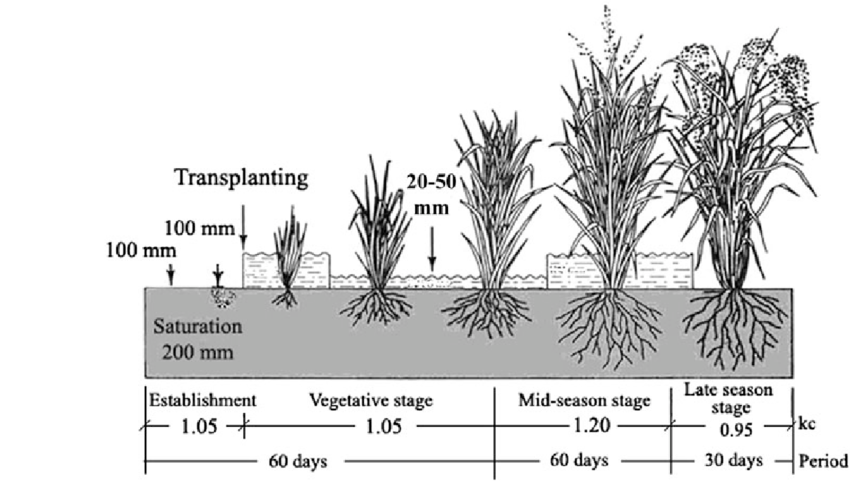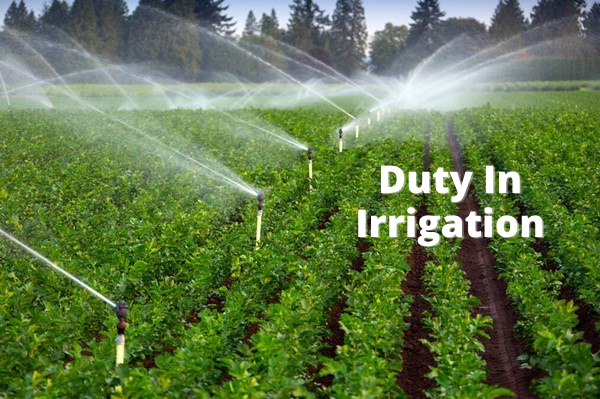Duty In Irrigation
1. Duty In Irrigation
The duty of water is the relationship between the volume of water and the area of land it matures. It may be defined as the area of land (in hectares) irrigated for full growth of a given crop by a supply of 1 m³/sec of water continuously during the entire base period of the crop.
Duty of water (duty in irrigation) is generally expressed in hectare/cumec and is denoted by the letter D.
D= A /Q
where,
D=Duty in hectare/cumec
A=Area in m2
Q=Discharge in m³/s
Duty can also be expressed as
D=8.64 B/Δ
Where;
B = Base period of crop
Δ = Delta of crop

2.Types Of Duty in Irrigation
1.Flow Duty
2.Quantity /Storage Duty
1.Flow Duty- In direct irrigation; water from the source is directly supplied to the irrigating field without storing it. Hence, the duty of water in direct irrigation is called flow duty.
2.Quantity Duty- In storage irrigation, water from the source is supplied to the reservoir or storage unit and then the required amount of water is supplied to the irrigation field from the storage unit. Hence, the duty of water in storage irrigation is Quantity Duty / Storage Duty.
Quantity duty is expressed in hectares /millions of cubic meters of water available in a reservoir. It means that every million cubic meters of water available to the reservoir will mature so many hectares of a particular crop.
The irrigating capacity of the reservoir is directly known which helps in determining the duty.
3.Factors Affecting the Duty in Irrigation
Duty in irrigation depends upon the following subsequent factor:
· Type of crop
The water demand for numerous crops is completely different. So, the duty varies from crop to crop.
The duty is less for a crop requiring a high amount of water and vice versa.
· Climate & Season
The duty varies from season to season and also from time to time in the same season. The duty also includes the water lost in evaporation and percolation.
Losses due to evaporation and percolation vary with climatic conditions. The values of duties which are generally expressed are their average values considered in the entire crop period.
Duty in the winter season & rainy season is more and less in the summer season.
· Useful rainfall
More rainfall leads to less requirement of irrigation water.
This means, if rain falls in the crop period then duty will be more and vice versa.
· Soil type
The duty in irrigation will be less for permeable soil and vice versa.
In coarse-grained soil; percolation is high, so duty is low.
n fined-grained soil; percolation is less, so high duty.
so the duty of clayey soil is more than the duty of sandy soil.
· Method of ploughing
Proper ploughing of the land reduces the number of watering & increases duty. But for faulty cultivation & improper ploughing, duty is decreased.
· Method of irrigation
The duty of water is high in the case of the perennial irrigation system as compared to the inundation irrigation system.
· The topography of agricultural land
If the agricultural land is uneven, the water requirement will be more and hence duty will be low and vice versa.
As the ground slope increases, the duty decreases as a result of the wastage of water.
· Base period
If the base period is longer, the water requirement will be more and duty will be low and vice versa.
· Skill of cultivation
A skilled & properly trained cultivator can make judicious use of water and therefore duty will be high
3.Factors Affecting the Duty in Irrigation
Duty in irrigation depends upon the following subsequent factor:
· Type of crop
The water demand for numerous crops is completely different. So, the duty varies from crop to crop.
The duty is less for a crop requiring a high amount of water and vice versa.
· Climate & Season
The duty varies from season to season and also from time to time in the same season. The duty also includes the water lost in evaporation and percolation.
Losses due to evaporation and percolation vary with climatic conditions. The values of duties which are generally expressed are their average values considered in the entire crop period.
Duty in the winter season & rainy season is more and less in the summer season.
· Useful rainfall
More rainfall leads to less requirement of irrigation water.
This means, if rain falls in the crop period then duty will be more and vice versa.
· Soil type
The duty in irrigation will be less for permeable soil and vice versa.
In coarse-grained soil; percolation is high, so duty is low.
n fined-grained soil; percolation is less, so high duty.
so the duty of clayey soil is more than the duty of sandy soil.
· Method of ploughing
Proper ploughing of the land reduces the number of watering & increases duty. But for faulty cultivation & improper ploughing, duty is decreased.
· Method of irrigation
The duty of water is high in the case of the perennial irrigation system as compared to the inundation irrigation system.
· The topography of agricultural land
If the agricultural land is uneven, the water requirement will be more and hence duty will be low and vice versa.
As the ground slope increases, the duty decreases as a result of the wastage of water.
· Base period
If the base period is longer, the water requirement will be more and duty will be low and vice versa.
· Skill of cultivation
A skilled & properly trained cultivator can make judicious use of water and therefore duty will be high
4. Importance of Duty
The knowledge of duty helps engineers in designing efficient canal irrigation systems.
Knowing the duty of different crops and their areas helps in estimating the discharge required for designing the Irrigation Canal or Piped irrigation.
5. Methods for Improving Duty
· Ploughing the land to proper depth increases the moisture-retaining capacity of the soil. Hence duty gets improved.
· Reduction in percolation loss. The canal should be lined to reduce percolation losses.
· Land used for cultivation should be levelled as far as possible.
· Manure fertilizers should be added to increase the water-holding capacity of the soil.
· Rotation of crops will ensure increased crop yield with minimum
· Method of irrigation should be efficient.
· The cultivators should be trained & skillful.
· The land should be regularly cultivated.
· Reduction of transmission losses. The canal or Pipe should be taken close lose to the irrigable land to minimize transmission losses


Marciat June 18, 2024
This article offers a fascinating perspective on the subject. The depth of research and clarity in presentation make it a valuable read for anyone interested in this topic. It’s refreshing to see such well-articulated insights that not only inform but also provoke thoughtful discussion. I particularly appreciated the way the author connected various aspects to provide a comprehensive understanding. It’s clear that a lot of effort went into compiling this piece, and it certainly pays off. Looking forward to reading more from this author and hearing other readers’ thoughts. Keep up the excellent work!
Melissat June 18, 2024
This article offers a fascinating perspective on the subject. The depth of research and clarity in presentation make it a valuable read for anyone interested in this topic. It’s refreshing to see such well-articulated insights that not only inform but also provoke thoughtful discussion. I particularly appreciated the way the author connected various aspects to provide a comprehensive understanding. It’s clear that a lot of effort went into compiling this piece, and it certainly pays off. Looking forward to reading more from this author and hearing other readers’ thoughts. Keep up the excellent work!
Zen Mastert June 20, 2024
Fantastic article! I appreciate how clearly you explained the topic. Your insights are both informative and thought-provoking. I’m curious about your thoughts on the future implications of this. How do you see this evolving over time? Looking forward to more discussions and perspectives from others. Thanks for sharing!
Nebula Navigatort June 21, 2024
Fantastic article! I appreciate how clearly you explained the topic. Your insights are both informative and thought-provoking. I’m curious about your thoughts on the future implications of this. How do you see this evolving over time? Looking forward to more discussions and perspectives from others. Thanks for sharing!